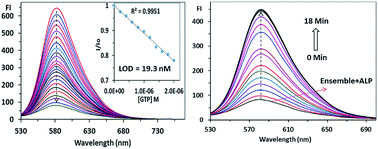A perylenediimide based ‘on-off’ chemosensor for the detection of nucleoside triphosphates: an efficient ensemble for monitoring alkaline phosphatase activity†
Abstract
The evaluation of the optical properties of BAB-PDI towards nucleoside polyphosphates (NPPs) in 90% aqueous media (pH 7.2) revealed that upon addition of guanosine triphosphate (GTP), the fluorescence intensity of BAB-PDI was >85% quenched. In the case of adenosine triphosphate (ATP), uridine triphosphate (UTP) and cytidine triphosphate (CTP), only 30–65% quenching of fluorescence intensity was observed. Other NPPs such as nucleoside diphosphates and monophosphates, respectively, caused 20–30% and <5% quenching of fluorescence intensity of BAB-PDI due to fewer negative charges on di- and mono-phosphates. The minimum limit of detection of GTP reached 19.3 nM. The application of BAB-PDI in monitoring enzyme (alkaline phosphatase) activity in aqueous solution using a BAB-PDI + GTP ensemble has also been demonstrated.



 Please wait while we load your content...
Please wait while we load your content...